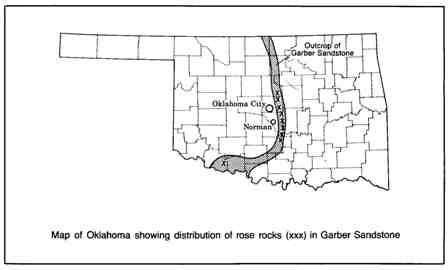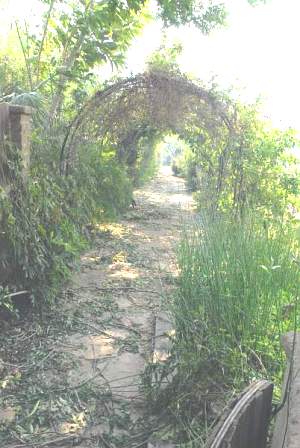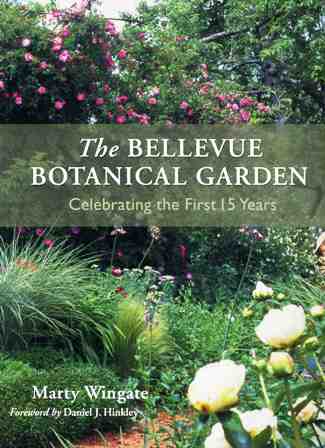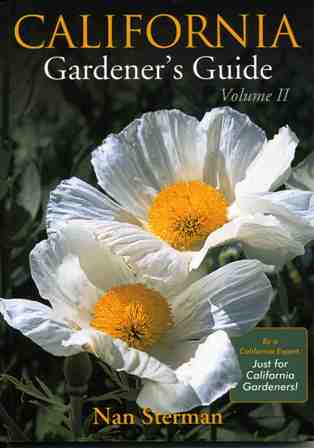About a month ago, I gathered with 500 or so of my closest friends to attend the annual Garden Writers Association symposium in Oklahoma City. We were treated to some amazing experiences, including a Country Western jam session under the stars, tours of private and public gardens, great speakers and workshops, lots of new plants, design inspiration and story ideas. And good friends, many of whom I see only once a year. For me, that’s the best part.
There were lots of goodies in our complimentary backpack, a multi-zippered number that sports the logo of Garden Writers Association and Total Environment, an Oklahoma City landscaping firm that sponsored many of our events.
Oklahoma rose rocks, resting on a gravel-lined tray. Nature, elevated to a higher art form.
Tucked inside was the very coolest gift of all. A rock. Yup, an earthy chunk of Oklahoma’s geological history. Round, reddish-brown, and measuring about 2 inches across, the rock was naturally formed and resembles a rose with a swirl of petals around the edges. I am fascinated by this little chip of stone.
“Rose rocks,” we soon learned, are an Oklahoma specialty. I’m so impressed that Oklahoma members of GWA’s host committee hand-collected hundreds of rose rocks to share with us, their visitors. I will cherish this special piece of their world and I can’t resist holding it in my hand and looking at this beautiful natural phenomenon. I just mentioned my fascination with the souvenir rock to a fellow GWA member who clearly wasn’t as excited about it as me. She said, “Oh, when I saw that, I wondered if it was an animal, vegetable or mineral. I thought it was edible.”
Well, my dear, uninitiated, rose rock-ambivalent friend, let me I quote here from the Oklahoma Geological Society brochure that came with our 2-inch specimen:
“Rose rocks, the reddish-brown sandy crystals of barite that resemble a rose in full bloom, are more abundant in Oklahoma than anywhere else in the world. They have been reported in small quantities in California, Kansas, and Egypt, but are in greatest concentration in the Permian Garber Sandstone in a narrow belt that extends 80 miles through the central part of Oklahoma between Pauls Valley and Guthrie.
“The rose-like appearance of the rock’s petal-shaped clusters is due to the intergrowth of crystals of barite (a mineral compound of barium sulphate, BaSO4) as a cluster of divergent blades. Barite was precipitated in interconnected voids in the rock, probably from barium-rich marine waters that covered the Permian Garber Sandstone during or shortly after its deposition about 250 million years ago.”
So, in other words: a quirk of nature, 250-million years ago, started this geological oddity that surprises us today. Awesome to think about.
Here are some other nifty rose-rock facts:
Most rose rocks are 1/2 to 4 inches in diameter and consist of 5 to 20 radiating plates.
The largest known single rosette is 17 inches across and 10 inches high and weighs 125 pounds.
Clusters of rosettes 38 inches tall and weighing more than 1,000 pounds have been discovered.
Gov. Dewey F. Bartlett declared the rose rock the official Oklahoma state rock in 1968.
We saw some larger rose rocks specimens on display in a few gardens, arranged on trays or in a curio cabinet like a Natural History Museum exhibit. Wow, these are cool. What’s a rock-lovin’ girl to do once she’s back home in LA? Hmmm. You bet. I checked eBay and typed in a search request: “Oklahoma Rose Rocks.” Lucky me, I found someone selling five batches of 2 rocks each and I was able to snap them up (and no, MA, you cannot have them. get your own rocks).
My little gathering of rose rocks, which for some reason make me very happy. Note the tiny, joined rosette pairs in the lower right
While awaiting my box of of rose rocks to arrive from Susan, the Oklahoma gal who sold them to me over the Internet, we swapped a few emails. I told her how fascinated I was with these perfectly-formed geological specimens. And she shared this funny recollection:
“…by the way, in my younger days, my grandfather used to curse these rose rocks, because they came up all over the place, especially in his rose beds! now people want them! i even have one that is 2 feet around and weighs 28 pounds! in my rose bed!!! thanks so much & God bless you!”
Upon closer inspection, they really do look like roses!
I’m eager to learn lots more about gardening in Oklahoma, especially after spending five days there in late September and early October. Luckily, I have a new guide in Dee Nash, a fellow GWA who shares her experiences living in a log house, gardening in Oklahoma and writing about it at www.reddirtramblings.com.













